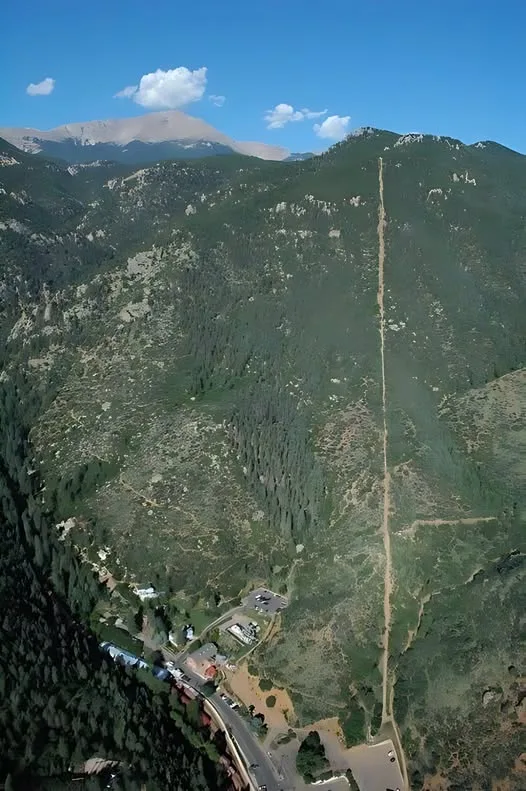Nestled in the charming town of Manitou Springs, Colorado, lies an epic challenge that beckons adventurers, fitness fanatics, and those simply seeking an unforgettable experience: the Manitou Springs Incline. This isn’t just a hike; it’s a vertical journey up what feels like an endless stairway to the sky, offering unparalleled views and an immense sense of accomplishment.
If you’re planning to tackle this iconic trail, or simply curious about what makes it so legendary, read on for your comprehensive guide to the Manitou Incline.

A Stairway Born from Rails: The Incline’s Fascinating History
Believe it or not, this formidable set of steps wasn’t originally built for hikers. In 1907, the Manitou Incline began its life as a narrow-gauge funicular railway. Its primary purpose was purely practical: to transport materials for the construction of pipelines and a hydroelectric plant high up on Pikes Peak.
Once its industrial duties were complete, the railway found a new life as a scenic tourist attraction. For years, visitors enjoyed a leisurely 16-minute ride to the summit, soaking in the breathtaking vistas. However, fate intervened in 1990 when a devastating rockslide damaged a significant portion of the track. The railway closed, and while the rails were eventually removed, the remaining railroad ties remained, creating an impromptu, incredibly steep stairway.
What started as an unofficial, and at times contested, hiking route quickly gained popularity among locals. After years of passionate debate involving safety concerns, environmental impact, and complex land ownership (the Incline crossed property belonging to three different entities!), the Manitou Incline was finally officially opened for recreational use on February 1, 2013. Today, it stands as a testament to perseverance, both for those who hike it and for the community that fought to preserve its unique character.
The Challenge: Over 2,000 Feet in Less Than a Mile
So, what makes the Manitou Incline such a formidable test? Let’s talk numbers:
- Vertical Gain: Prepare to ascend over 2,000 feet (approximately 615 meters) in a blistering short distance of less than a mile (about 0.88 miles or 1.4 km).
- The Steps: You’ll be climbing approximately 2,768 steps, all fashioned from those original railroad ties. Be warned: they are uneven, vary in height, and require constant vigilance.
- The Grade: The average grade is a staggering 41%, with sections that rocket up to 68% – yes, it can feel like you’re climbing a ladder straight into the clouds!
- Altitude: Starting at around 6,530 feet (2012 meters), you’ll reach a summit elevation of about 8,550 feet (2606 meters). For those visiting from sea level, acclimatization is key to avoid altitude sickness.
This is not a casual stroll. It’s an “extremely difficult” hike that pushes your cardiovascular endurance and leg strength to their limits. While elite athletes can sprint to the top in under 30 minutes, most hikers can expect to take an hour or more for the ascent. The entire round trip, including the descent, typically takes 3-4 hours for an average person.
Planning Your Ascent: Essential Tips for a Successful Hike
The Incline is a beloved natural asset, and proper planning helps preserve it and ensures a safe experience for everyone.
- Reservations are a MUST: To manage crowds and protect the trail, a free online reservation is required to hike the Incline. These reservations often open weeks in advance, so plan ahead!
- Hours of Operation: The Incline is open from 6 a.m. – 3 p.m. during winter (November 1 – April 30) and 6 a.m. – 6 p.m. during summer (May 1 – October 31).
- Parking Smart: Forget trying to park at the trailhead. Instead, utilize the designated paid parking options:
- Dillon Mobility Hub (134 Manitou Ave): Preferred option, $5 daily, with a free Route 3 shuttle to the trailhead.
- Hiawatha Gardens Parking Lot: Another good paid option with a free shuttle running every 20 minutes.
- Iron Springs Chateau Parking (444 Ruxton Ave): A cash-only, fee-based lot ($15 for 4 hours).
- Avoid Illegal Parking: Seriously, don’t park in prohibited areas (like Barr Lot unless you’re using Barr Trail, or residential streets without a permit). Tickets are frequently issued.
- Descent is Different: This is crucial! For safety reasons, downhill use of the Incline steps is strictly prohibited. All hikers must descend via the Barr Trail, a scenic but still challenging 3-mile (approx. 4.8 km) path that connects directly at the Incline’s summit.
Safety First: What to Bring and How to Prepare
Conquering the Incline requires more than just grit; it demands smart preparation:
- Hydration is Key: Bring ample water – more than you think you’ll need. Dehydration, especially at altitude, can be dangerous.
- Snacks: Fuel your body with energy-rich snacks.
- Sun Protection: The Incline is exposed. Wear sunscreen, a hat, and sunglasses.
- Proper Footwear: Sturdy hiking boots or supportive athletic shoes with good grip are essential. The steps are uneven, and footing can be tricky.
- Weather Watch: Colorado weather changes rapidly. Check the forecast and be prepared for sudden shifts, especially summer thunderstorms (avoid being on the Incline during lightning).
- Listen to Your Body: If you feel dizzy, nauseous, or experience severe shortness of breath, turn back. There are “bail-out” points at railroad tie 396 and 1300 that connect to the Ute Pass Trail for an earlier return.
- No Pets: For the safety of animals and hikers, pets are not allowed on the Incline.
- Respect the Trail: Pack out everything you pack in. Stick to the designated path – no short-cutting or creating new trails.
The Reward: Views and Bragging Rights
While the ascent is undeniably grueling, the reward at the summit is immense. You’ll be treated to panoramic views of Colorado Springs, the majestic plains stretching eastward, and the rugged beauty of the Rocky Mountains to the west. And, of course, there’s the unparalleled sense of accomplishment that comes with conquering one of Colorado’s most challenging and iconic trails.
The Manitou Springs Incline is more than just a hike; it’s an experience that tests your limits and leaves you with lasting memories. So, make your reservation, lace up your boots, and get ready to climb your way to one of the most rewarding vistas in Colorado!





